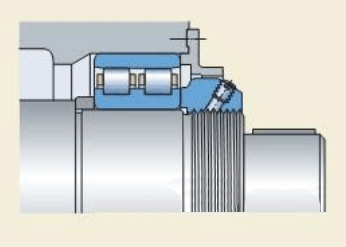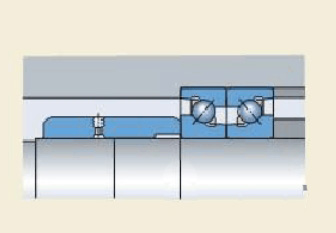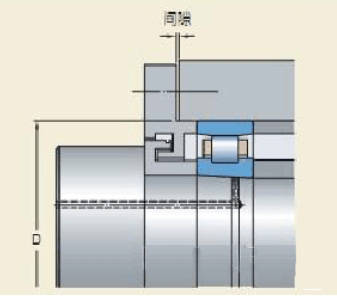Bearing fixing method
The bearing fixing method is not enough to axially locate the bearing ring only by interference fit. Generally, some suitable methods are needed to axially position the bearing ring.
The inner and outer rings of the locating bearing should be fixed axially on both sides. For non-locating bearings with inseparable structure, such as angular contact ball bearings, one bearing ring adopts a tight fit (usually the inner ring) and needs to be fixed axially; the other bearing ring can move axially freely relative to its mounting surface . For non-locating bearings with separable structure, such as cylindrical roller bearings, both the inner and outer rings need to be fixed axially. In machine tool applications, the working-end bearing usually transmits an axial load from the shaft to the bearing housing to locate the spindle. Therefore, the bearing at the working end is usually positioned axially, while the bearing at the driving end is free to move axially.
The following four examples illustrate bearing fixing methods:
1. Positioning method of lock nut
When using an interference fit bearing inner ring, the inner ring is usually placed against the shoulder on the shaft, and the other side is usually fixed with a lock nut (KMT or KMTA series).
Bearings with tapered holes are directly mounted on the tapered journal, usually fixed on the shaft with a lock nut.

2. Spacer positioning method
It is very convenient to use spacers or spacers between the bearing rings or between the bearing rings and adjacent parts instead of the integral shaft shoulder or bearing seat shoulder. In these cases, dimensional and shape tolerances also apply to related parts.

3. Positioning of stepped shaft sleeve
Another method of axial positioning of bearings is to use a stepped sleeve. These bushings are particularly suitable for precision bearing arrangements. Compared to threaded lock nuts, their runout is smaller and provides higher accuracy. Stepped sleeves are usually used for ultra-high speed spindles. For such spindles, traditional locking devices cannot provide sufficient accuracy.

4. Positioning method of fixed end cover
When using an interference fit bearing outer ring, one side of the outer ring is usually placed against the shoulder on the bearing seat, and the other side is fixed with a fixed end cover.
The fixed end cover and its fixing screws have a negative impact on the bearing shape and performance in some cases. If the wall thickness between the bearing seat and the screw hole is too small, or the screw is tightened too tightly, the outer ring raceway may be deformed. The lightest ISO size series 19 series is more susceptible to such damage than the 10 series or heavier series.
It is advantageous to use a large number of small-diameter screws. Avoid using only 3 or 4 screws. Because there are few fastening points, protrusions may be formed in the bearing housing holes. This will produce variable friction torque, noise and unstable preload (when using angular contact ball bearings). For spindles with complex design and limited space, only thin-walled bearings and a limited number of screws can be used. In these examples, it is recommended to accurately check the deformation by FEM (Finite Element Method) analysis.
In addition, the axial clearance between the bearing housing end face and the end cover flange should also be checked. The guideline value is 10-1 5μm/100mm bearing hole diameter.
